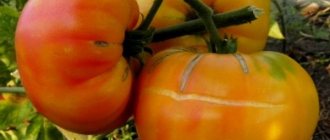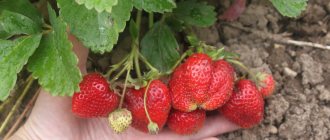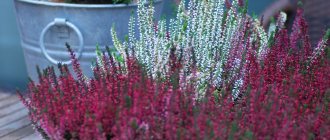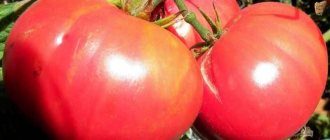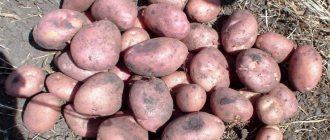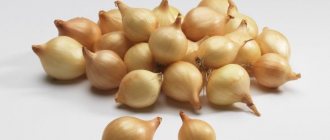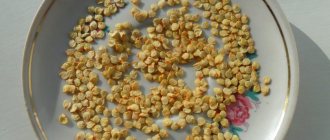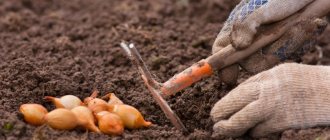Author's rating
Author of the article
Yakov Pavlovich
Professor, Head of the Department of Vegetable Growing
Articles written
153
One of the excellent greenhouse tomato varieties is the Tretyakovsky f1 tomato, reviews of which are extremely positive. This is an indeterminate variety, which is grown mainly in greenhouses, requires pinching and produces large, fleshy fruits with a rich taste. Tretyakovsky f1 tomatoes delight gardeners with large yields and long shelf life.
History of the Tretyakovsky variety
The Tretyakovsky f1 variety was bred by breeders from the Urals, who sought to create a type of tomato that would grow well in the greenhouse conditions of the harsh north. As a result, after several crossings of completely different varieties, they bred mid-early Tretyakovsky tomatoes of unlimited growth and with fleshy fruits.
The variety was officially registered in the State Register in 1998, and in 1999, after numerous tests, it was recognized as meeting all the declared characteristics. The hybrid on the market is labeled F1, which means a strong predominance of maternal characteristics in the tomato.
Feeding and watering tomatoes in a greenhouse
Foliar feeding of Tretyakovsky F1 tomatoes is not practiced, since the humid environment of the greenhouse can cause the occurrence and rapid spread of infections. The solution for fertilizing the soil is prepared per 10 liters of water:
- the first time dissolve 20 g of ammonium nitrate, 50 g of double superphosphate and 10 g of potassium chloride. Fertilizer is applied one to two weeks after transplanting the sprouts;
- as soon as ovaries form on the bushes, add a solution of 80 g of double superphosphate and 30 g of potassium nitrate;
- the third time during the ripening period, a solution of 40 g of double superphosphate and 40 g of potassium nitrate is added.
Watering rules
Young seedlings are watered sparingly as the soil dries. During the ripening period of Tretyakovsky F1 tomatoes, there should not be a lack of moisture, so watering is required infrequently, but plentifully. It is advisable to carry out the procedure during the day, then the water will be warm enough and you can have time to ventilate the greenhouse well before the evening temperature drops.
Advice! When watering, water should not fall on the stems or leaves. To prevent a greenhouse effect from occurring after irrigation, it is recommended to regularly ventilate the greenhouse.
The optimal option for watering tomatoes of the Tretyakovsky F1 variety is equipment of a drip system. At the same time, the structure of the top layer of soil is preserved, there is no sharp change in soil moisture, and a minimum of effort is expended on the process.
Description and characteristics of tomato
The variety is indeterminate - this means that if you do not pinch its top, the bush will grow indefinitely (average height 150 cm). Therefore, it needs pinching and tying the stem to a support. Designed for cultivation in greenhouse and greenhouse conditions, but in the southern regions it also grows in fields. Tomato bushes are compact because they do not grow too much foliage. It produces high yields when grown in 2-3 stems.
The fruits ripen in clusters of 7-8 pieces each, with the weight of one of them being about 90-150 grams. They have a round shape, rich raspberry color and sugary pulp. Tomatoes do not have ribs, they have a dense skin, thanks to which they can be transported or stored in the basement for a long time.
The variety is a hybrid, it is resistant to various diseases and parasitic insects, grows well in the shade and produces a bountiful harvest. Fruit ripening period is 100-115 days from the moment of first shoots.
Description of the tomato variety Tretyakovsky
According to the description of the originators, the Tretyakovsky tomato belongs to the mid-late, indeterminate species. This is a rare variety of tomato that does not stop growing throughout the growing season. If the height is not artificially limited, it can reach 6 meters. To stop growth, it is necessary to break the top of the main trunk at the desired level. Typically, growth adjustments are based on the height of the greenhouse and the trellis installed in it.
The tomato variety is recommended to be grown in closed areas and open ground. For the Southern and North Caucasus districts there is no need for film shelter. The Tretyakovsky variety is cultivated in temperate climates only in greenhouse structures. A high yield is achieved by forming a bush with two trunks: the first is the main stem, the second is a strong stepson left behind. This method helps to unload the tomato without losing fruiting.
External characteristics of tomato:
- The variety produces a large number of shoots of a light green hue, which must be removed throughout the entire growth period. The main stem is rigid, the color is close to brown with a greenish tint. The structure of the fibers is woody and dense. The indeterminate type of growth affects the stability of the stem; it cannot support the weight of fruit on its own, so fixation to a support is necessary.
- The foliage of the Tretyakovsky tomato is intense, the leaves are darker than the shoots, have an oblong shape, carved along the edges, the surface structure is corrugated, very fleecy. To avoid shading and irrational use of nutrients, it is recommended to remove the lower foliage and thin out the main trunks.
- The root system of the tomato variety is superficial, powerful, growing to the sides. Completely supplies tomatoes with nutrition and ensures plant stability.
- The hybrid tomato “Tretyakovsky F1” blooms profusely, the plant is self-pollinating, bright yellow flowers produce 99% viable ovaries.
- Tomatoes are arranged on clusters of 9 pieces. Clusters are formed through three leaves. On subsequent shoots, the weight of the fruits does not differ from the first circle, but fewer ovaries are formed, and the density of the last thunderstorm is 5 pieces.
Attention! The Tretyakovsky tomato variety is medium-late: from the moment the seedlings are planted in the ground until the biological ripeness of the fruit, 4.5 months pass; the first tomatoes are harvested at the end of August - the first ten days of September.
Description of fruits
According to reviews from vegetable growers, the Tretyakovsky tomato variety produces fruits of the same weight; the weight of the tomato does not decrease as subsequent clusters form. Tomatoes do not ripen at the same time; the last circle in open ground is picked at the stage of technical or milk ripeness. Green tomatoes ripen well in a darkened room. Characteristics of the fruits of the Tretyakovsky variety:
- round in shape, slightly concave inward at the base;
- weight within 125 g;
- the color is raspberry with a pink tint, unripe tomatoes are dark green, there is a light yellow fragment near the stalk;
- the peel is thin, elastic, and does not crack;
- the surface structure of tomatoes is smooth, without ribbing;
- the pulp is raspberry, juicy, dense consistency;
- this tomato variety produces few seeds, they are located in three sections;
- the taste is sweet with a slight concentration of acid.
Advice! The fruits are suitable for consumption only after full ripening; unripe tomatoes have hard, white fragments in the pulp.
Main advantages and disadvantages of the variety
The hybrid variety Tretyakovsky is resistant to fungal and bacterial diseases and is not attacked by insect pests. Its other advantages include:
- high productivity;
- drought resistance;
- resistance to temperature changes;
- bright rich taste of fruits;
- the strength of tomatoes, allowing them to be transported.
Among the disadvantages of the variety is the need to tie them up and control the biomass. Some gardeners find it a disadvantage that you cannot get seeds from tomatoes - you have to buy them every time.
Expert opinion
Stanislav Pavlovich
Gardener with 17 years of experience and our expert
Ask a Question
Important! Tretyakovsky tomatoes are self-pollinating; flowers in 99% of cases develop into a viable ovary.
Brief information about the variety
- Fruits and bush : raspberry-colored tomatoes. Weight – 100-130 g. Bush – determinate, reaches 1.2-1.5 m.
- Productivity : up to 6 kg/m².
- Resistance : tomatoes are highly resistant to frost, fungal diseases and a large number of pests.
- Distribution : Can be grown in all areas and is suitable for both greenhouse and open soil conditions.
- Application : fruits are excellent for canning, making juices and sauces.
- Planting : use the seedling method. The process is carried out in early May, the scheme is 40x60.
- Soil : It is better to choose light soil rich in nutrients.
- Care : watering - once every 7 days. Fertilizing is carried out 3 times during the season, every 14 days. Pinching - requires the formation of 2-3 stems.
- Ripening period : the crop ripens in July. Fruiting lasts until August. You can store ripe fruits for a month at a temperature of no more than 3°.
Recommendations for growing crops
Indeterminate varieties always require increased attention - they must be tied, pinched, and crown growth controlled. Nevertheless, they reimburse all costs doubly - the yield of such varieties is extremely high. Tretyakovsky tomatoes also require crown care and need regular watering and fertilization.
See also Maryina Roshcha tomatoes: growing and caring for the variety
Planting seedlings
Seeds are sown 2 months before the expected date of planting in the greenhouse. To do this, you need to prepare the soil in advance; it is best to purchase one prepared specifically for tomatoes. You can also collect the soil yourself - to do this you need to take equal parts of garden soil, sand and compost.
The sowing process occurs in several stages:
- The soil is disinfected with a manganese solution and calcined in the oven - this will help kill all bacteria and fungal spores.
- The seeds are usually calcined and disinfected at the factory, but for prevention they can also be watered with manganese.
- For faster germination, the seed should be soaked in a growth stimulator or simply placed on a damp cloth and constantly moistened so that the sprouts begin to hatch.
- Pour the soil into one large box and make grooves in it up to 1 cm deep.
- The seeds are laid out in rows individually at a distance of 2 cm.
- The rows are covered with soil and irrigated with a sprayer. The box is covered with film and placed in a warm place.
- The seedlings germinate within a week.
You should carefully monitor the crops in order to pick them immediately after they have 2 true leaves.
Transfer
As soon as the sprouts produce a pair of true leaves, they need to be transplanted into a separate container - pricked. This will allow the root system to grow in breadth, capturing all the chernozem nutrient layers of the earth. In mid-April, the seedlings are hardened off - they are regularly taken out to the greenhouse for the whole day, taken into the house only at night.
And at the end of April-beginning of May they begin to transplant into greenhouse soil or into the garden. To do this, form a bed where the holes are located at a distance of 65 cm from each other so that per 1 sq. m there were no more than 4 tomato bushes. The bushes are buried and covered with earth, abundantly irrigating the bed with a shallow watering can.
Expert opinion
Stanislav Pavlovich
Gardener with 17 years of experience and our expert
Ask a Question
Important! It is best to plant seedlings in peat pots - they are planted in the ground along with the roots, which shortens the process of seedling adaptation to the soil.
Characteristics of the variety
According to the characteristics, the Tretyakovsky hybrid tomato is a high-yielding crop. Thanks to the genetic material of the parent varieties, it tolerates low temperatures well. Fruits in both sunny and shaded areas. It does not require special agricultural technology, is practically not affected by pests, and is resistant to most infections.
Productivity and fruiting
The indeterminate variety “Tretyakovsky” is a high-fruiting tomato. Forming a bush with two shoots eliminates the need to remove brushes and part of the fruit. The hybrid is adapted to weather conditions of temperate climates. Growing in indoor structures does not require additional heating or lighting.
In open ground, tomatoes feel comfortable both with an excess of ultraviolet radiation and with its deficiency. Rainy summers and drought do not play a big role in the yield of this tomato variety. In an open area, the degree of fruiting will be less due to the height of the plant and planting density. In greenhouses, one tomato yields up to 7 kg, three tomatoes are placed per 1 m3, the yield is up to 20 kg. On an open seat up to 18 kg. Harvesting occurs on the 130th day after planting the seedlings (August, September).
Area of application of fruits
The Tretyakovsky tomato variety is grown in greenhouses and on small farm plots for sale and personal use. The hybrid is not cultivated on a production scale due to the high price offer for planting material. In gardens and summer cottages, harvested tomatoes are consumed fresh. Suitable for making juice, homemade tomato paste, canning in general, pickling.
Resistance to diseases and pests
The Tretyakovsky tomato variety is a breeding crop that took some time to develop. Tomatoes grown in closed areas are immune to pests; insects do not parasitize the crop. In open ground, damage occurs by the larvae of the Colorado potato beetle. Bacterial, viral or fungal infection does not occur in southern regions. In temperate climates, high humidity in greenhouses can provoke tobacco mosaic on the leaves or cladosporiosis.
Advantages and disadvantages of the variety
The conditional disadvantages of the Tretyakovsky tomato include the need to form a bush, garter, and remove stepsons. The “Tretyakovsky” tomato variety is a hybrid of one year of growing season; the seeds from the parent plant the next year will produce other tomatoes that are radically different from the varietal characteristics of the “Tretyakovsky” tomato.
Positive traits:
- The indeterminate type of growth allows you to place several plants in a small area.
- The high yield of the variety is not reduced by the influence of negative factors.
- The tomato variety is genetically resistant to parasites and infections.
- Long period of tomato harvesting (until the first frost).
- Cultivated in greenhouses and open ground.
- Well stored and transported.
- High gastronomic appreciation of the fruit. Universal tomatoes.
Plant care tips
After successfully planting seedlings in the soil, tomatoes require regular watering, fertilization and, of course, crown formation. Since the variety is tall, its stem without proper care can grow up to 8 m in length, which will negatively affect the quality and quantity of the harvest. Therefore, seedlings must be regularly inspected, trimmed and pinched.
Garter and bush formation
As soon as the tomato bushes grow more than 60 cm in height, they should be tied up. To do this, you can hammer a peg near each seedling or stretch a wire along the row. They should be tied with strips of fabric, having previously been disinfected with manganese.
The formation of the bush occurs throughout the summer:
- dried leaves are removed;
- large branches without ovaries and flowers are pruned;
- stepsons are cut off;
- the crown is thinned out from large leaves;
- The leaves located below the first cluster with fruits are torn off.
After the first flower cluster appears, stepsons begin to grow, which should be removed regularly. You can leave only one - it develops under the first brush with flowers and is the most powerful. All stepchildren that are located below this must be removed.
Feeding
Tretyakovsky tomatoes are fertilized only at the roots - otherwise a bacterial or fungal disease may develop from the humidity in the garden. It is best to use a special mixture of ammonium nitrate, superphosphate and potassium chloride, dissolved in 10 liters of water. Fertilize tomatoes three times per season:
- 10 days after planting in the ground;
- when does the first ovary appear;
- during the process of fruit ripening.
See also Characteristics, description and cultivation of tomato variety Zemlyak
Fertilizers are applied along with water at the root of the bush. After this, the bed is once again well irrigated from a watering can.
Watering rules
Tomatoes are always watered moderately, focusing on the soil moisture in the garden bed. Tomatoes require regular, deep watering 2-3 times a week. When watering, you should follow some rules:
- the water should be warm and settled;
- Greenhouse tomatoes should be watered during the day, and in the morning or evening in open ground;
- When watering, water should not fall on the leaves and stems.
It is important not to wash away the roots of the seedlings as soon as they are planted in the ground, and not to knock down the ovary flowers with a stream of water, so it is best to water the tomatoes from a shallow watering can.
Features of planting and growing Tretyakovsky tomatoes
Since the greenhouse cultivation option is most often chosen for the Tretyakovsky tomato, seeds for seedlings can be sown early, already at the end of February, so that at the age of just over two months the bushes can already be transplanted into the greenhouse. If the greenhouse is heated, this can be done even earlier. In ordinary film greenhouses in the middle zone, tomato seedlings are usually planted in the first half of May, closer to the middle of the month.
Usually the seeds of this hybrid are sold ready for sowing; they can be sown in boxes and dry; soaking and swelling will give a maximum gain in 1–2 days, and there is no need to mess with this. The process of growing seedlings proceeds without any special features: at two weeks of age, the seedlings are planted in separate cups of not the smallest size. Watering is carried out rarely and moderately; fertilizing, provided the soil is good, may not be necessary.
Typically, seedlings of this tomato grow quite viable and normal in size.
Seedlings are planted in the garden bed no earlier than when the soil warms up to 14 °C. The scheme is any convenient, but only three bushes are placed per square meter. The stakes for the garter are driven in immediately, but it is even better if it is possible to build a trellis. In addition, equipping the greenhouse with a drip irrigation system has a great positive effect. If this is not the case, you need to constantly monitor the condition of the soil. Tretyakovsky is a drought-resistant variety, and if you miss watering one day, nothing will happen. But in a greenhouse, overwatering will be much more dangerous, which, coupled with insufficient ventilation of the room, can provoke diseases.
This tomato is fed according to the usual pattern, three times a season. The bushes are formed using a two-stem system: one of the first stepsons acts as the second stem. The remaining stepsons systematically break them out. As the fruits grow, the stems are tied repeatedly to prevent them from breaking off. Excess leaves are torn off: first of all, this applies to yellowing ones, then it’s time for those that cover the tomatoes from the sun. The harvest is harvested as it ripens, but with the arrival of cold weather, green tomatoes also have to be harvested.
Video: Tretyakovsky tomato from seed to harvest
Diseases, pests and prevention
This hybrid has high resistance to fungal diseases and parasites, so it does not need to be constantly watered with fungicides or other drugs. The main disease that can affect seedlings is late blight. As a preventive measure you can:
- sprinkle the rows with tobacco dust from parasites or wood ash;
- water the beds with soapy water;
- spray plants with Fitosporin or Bordeaux mixture during cold rainy weather against fungus;
- Ventilate the greenhouse to avoid infestations of slugs and snails.
Careful preparation of the soil in autumn and spring, as well as calcination of the soil for seedlings, will help avoid fungal infections.
Useful video
Watch the video: review of the sweetest varieties of tomatoes
In the table below you will find links to other varieties of tomatoes presented on our website and having different ripening periods:
| Early ripening | Mid-late | Mid-early |
| Raspberry Viscount | Yellow banana | Pink Bush F1 |
| The Tsar Bell | Titanium | Flamingo |
| Kate | Slot F1 | Openwork |
| Valentina | Honey fireworks | Cio Cio San |
| Cranberries in sugar | Miracle of the market | Supermodel |
| Fatima | gold fish | Budenovka |
| Verlioka | De Barao black | Major F1 |
If you find an error, please select a piece of text and press Ctrl+Enter.
Collection and storage
The yield of Tretyakovsky tomatoes is extremely high - from 1 sq. m of land you can collect 12-14 kg of ripe fruits. Usually the harvest is harvested 100-110 days after the first shoots - this happens in the third ten days of September. Tomatoes are cut from the stem and placed in wooden storage boxes. They can last up to 14 days in the basement.
Tomatoes are used to prepare fresh salads and appetizers; all kinds of lecho, adjika and other hot dishes are prepared from them. Whole tomatoes are not canned, but are rolled into jars as part of snacks and as tomato juice.
Features of growing the variety
The timing of planting seeds is determined based on the method of cultivation and the climatic characteristics of the region. At home, seedlings will grow for about 2 months. Moreover, seedlings are transferred to open ground a week later than to the greenhouse. Therefore, it is recommended to start planting at the beginning of March (in the south - at the end of February).
Initially, Tretyakovsky tomato seeds are grown in a mini-greenhouse:
- Prepare a mixture of garden soil and peat (1:1).
- Heat it in the oven (20-30 minutes, 130 degrees).
- The seeds are buried 1 cm, interval 2-3 cm.
- Water and cover with film.
- Place containers (boxes or containers) in a warm place (24-26 degrees).
After the sprouts appear, the film is removed. As soon as 2-3 leaves are formed, they dive into plastic glasses or pots. A few days later, complex fertilizer is added and then grown at room temperature. If necessary, illuminate until the total daylight hours are 14-15 hours. 2 weeks before transplanting Tretyakovsky tomato seedlings into the ground, hardening begins (at a temperature of 15-16 degrees).
Tretyakovsky tomatoes tolerate shade well, so they can be planted at intervals of 50 cm
The bushes are transferred in mid-May or closer to the beginning of June (in the Urals and Siberia), planted with an interval of 60 cm between plants and 70 cm between rows. Further care comes down to several rules:
- Watering 1-2 times a week.
- Feed with mullein, chicken droppings or other organic matter once every 2-3 weeks.
- Regular loosening of the soil.
- Mulching, weeding.
- Pinching, forming a bush with 2 stems.
- Tying to a support.
Planting scheme
After the preparatory work in the greenhouse, beds can be formed. In order for the soil to warm up faster, the height of the ridges is made up to 25 cm, and the width is on average 60-90 cm. Before planting, the soil temperature is measured at a depth of 20 cm. If it is below 13 degrees, then there is no point in planting tomatoes; at this temperature they will not grow. To warm the earth, it is covered with a film, preferably black.
You may be interested in: Dates for planting tomato seedlings in open ground and greenhouses according to the garden calendar Favorable days for planting tomatoes for seedlings in 2021 according to the lunar sowing calendar Favorable days for picking tomatoes in 2021 after germination: timing of picking tomato seedlings in the table by day
When forming a Tretyakovsky tomato into two stems, it is recommended to plant no more than three seedlings per square meter. When formed into one main trunk, it is allowed to plant four plants per square meter. It is more comfortable for tomatoes to grow with a checkerboard planting pattern in two rows. In this case, each plant receives a sufficient amount of light and oxygen.
Characteristics
The fruits are small and very beautiful; they will look great preserved. Their taste will be appreciated if they are consumed fresh. Juices and pastes from Tretyakovsky hybrid tomatoes are not only very tasty, but also healthy, thanks to the high content of vitamins and sugars.
When good conditions are created, up to 5.5 kg of excellent fruits can be guaranteed to be harvested from one plant. Recommended planting density is 3 bushes per square meter. m, it turns out 15-16 kg. This is a very good indicator of productivity.
You can compare the yield of the Tretyakovsky variety with other varieties in the table below:
| Variety name | Productivity |
| Tretyakovsky | 15-16 kg per square meter |
| Russian size | 7-8 kg per square meter |
| King of Kings | 5 kg per bush |
| Long Keeper | 4-6 kg per bush |
| Grandma's gift | up to 6 kg per square meter |
| Podsinsky miracle | 5-6 kg per square meter |
| Brown sugar | 6-7 kg per square meter |
| American ribbed | 5.5 kg per bush |
| Rocket | 6.5 kg per square meter |
| De Barao the giant | 20-22 kg per bush |
Among the advantages of this type of tomatoes are noted:
- very high immunity;
- good yield;
- tolerance to temperature changes and lack of moisture;
- versatility of crop use.
Among the disadvantages it is worth highlighting:
- it is difficult to get real high-quality seeds;
- branches need support, this can be confusing for beginners;
- During plant growth, attention to watering and fertilizers is required.
Growing rules
The Tretyakovsky tomato is a hybrid that does not produce seeds for the next generation. Planting material is purchased on Internet sites or in retail outlets. The seeds are treated with an antifungal agent; no additional disinfection is required.
Seedling
Tomato seeds are planted for seedlings in pots when about 65 days remain before planting in the ground. Each gardener must calculate this date himself, since it is different for different regions.
We must not forget that before planting seeds in the ground, they must be treated with a weak solution of potassium permanganate and the floating seeds must be planted in the ground. But some people prefer to germinate them first to obtain better seedlings. To do this, they are placed in a wet cloth.
Both gardeners are right. However, with the second option, you can immediately see which seeds are alive, and in the first option, the probability that you guessed the living seeds is lower.
In the first weeks (up to 3 on average), the seedlings form a root system, so growth is very slow. During this period, you should not get carried away with watering, and fertilizing can only be done once.
As soon as the first leaf appears, the plant begins to grow. This is where you need to pay special attention to temperature and sunlight. The alarm should be sounded if the plant begins to grow very upward, it means it is hot.
In order for the seedlings to be strong and not pampered, they must be in a cool place, on the non-sunny side, since they do not require strong sun. However, you need to monitor the length of daylight hours; it should not be less than 12 hours.
In this case, the Tretyakovsky tomato will grow green mass rather than grow a stem. At this time, you need to increase watering and do not forget to feed the plants. If you do not follow these recommendations, the tomatoes will take a long time to take root and become sick when transplanting.
When the plant reaches a height of about 10 cm (on average), and there is not one, but as many as 5 leaves on the stem, it is necessary to monitor its formation.
For example, make sure that it does not overgrow, has comfortable conditions, sufficient lighting, watering with organic matter and always a moderate temperature in the place of cultivation. Water a little more often, but not more than twice a week. A few days before the high-rise, you need to start hardening the tomatoes, at least 10 days.
dachamechty.ru
Landing in the ground
When the seedlings grow, they can be planted in open ground or a greenhouse. The fact that the tomatoes are ready for planting is indicated by their appearance. So it is believed that the height of the trunk should be up to 25 cm, thickness - up to 7 cm, and the number of leaves should be at least 7-9 pieces.
Typically, gardeners plant tomatoes in greenhouses somewhere starting in May. Planting in open ground takes place in early June, when the temperature reaches 15, and preferably 25 degrees. In this case, the seedlings will take root better.
With proper planting, beautiful well-groomed bushes of Tretyakovsky tomatoes will appear in the beds. Outwardly more like an ornamental plant, its beauty is said to be “like in the Tretyakov Gallery.”
The peculiarity of this type of bush is that it has quickly and frequently growing shoots. Therefore, it constantly needs pinching and tying up the plant mass.
It is best to form a crown with several stems, but do not let it grow upward. Since this tomato is a hybrid, its length can reach eight meters, which is not necessary, so you need to pinch the main stem.
In this case, the bush will grow wider. Therefore, you need to leave only 2 shoots from the bush, remove the others. Otherwise, the shadow created by the foliage will cause problems for other neighboring plants.
dachamechty.ru
Care instructions
Caring for the Tretyakovsky-f1 hybrid in greenhouse conditions is very easy and even novice amateur vegetable growers can do it. Proper cultivation is the basis of the future harvest, and the main stages of caring for greenhouse tomatoes are as follows:
- It is optimal to water the plants early in the morning with water whose temperature is approximately 20−22 °C;
- Before the active flowering stage, tomatoes should be watered every four to five days, spending about five liters of water per square meter;
- during the phase of mass flowering of vegetable crops, watering must be increased and about one bucket of water must be used for each square meter;
- Providing tomato bushes with a comfortable temperature regime and optimal humidity is a guarantee of obtaining a high-quality and high yield;
- to ventilate the greenhouse space, it is recommended to periodically open the side or top windows, as well as doors;
- It is especially important to provide the plants with good ventilation approximately two hours after watering;
- temperature readings inside the greenhouse during the daytime can be approximately 24−26 °C, and at night the temperature should be at 15−16 °C;
- A prerequisite for proper greenhouse cultivation is to garter tomatoes approximately on the fourth day after planting.
High productivity indicators of the hybrid require proper feeding of the plants. Two weeks after planting the seedlings, it is necessary to carry out the first fertilizing with a solution of nitrophoska or liquid mullein, diluted in a bucket of water at the rate of 1 tablespoon or 500 g, respectively.
The second feeding should be provided to greenhouse tomatoes after ten days, using a solution based on a teaspoon of potassium sulfate diluted in a bucket of warm water. To get a high yield, it is enough to carry out about three or four fertilizing per season.
moyateplica.ru
Caring for mature plants
Caring for tomatoes after transplanting into a greenhouse consists of the following agrotechnical techniques:
Stepsonning:
Removal of stepsons from plants of this variety must be carried out regularly once every 3-5 days throughout the season. Simultaneously with pinching, the bush is formed into one or two stems. When forming into one stem, all side shoots without exception are removed; when forming into two stems, one strongest stepson is left under the first fruit cluster.
Tying:
By the time they are planted in the greenhouse, the bushes have already reached a height of 25-30 cm, and after a couple of weeks of growth they even reach half a meter. Liana-type bushes are not able to support their weight even without fruits and therefore need support and tying.
Watering:
Watering for such tall plants with a large number of fruits should be plentiful, but rare. The root system of the Tretyakovsky tomato is very powerful and goes deep into the ground. Therefore, watering should be appropriate, about 10-12 liters per bush.
Advice! It is known that the more flowers are pollinated, the greater the harvest. There is no wind or insects in greenhouses, which help plants in this important process. Therefore, during flowering, it is recommended to carefully shake the bushes and ventilate the greenhouse more often.
Feeding:
Since the tomato sets a large number of fruit clusters throughout the season, even well-fertilized soil is gradually depleted. In addition, at different stages of development, the plant requires different nutrients. Feeding should be carried out at least once every two weeks, taking into account the phase of plant development and its needs.
Loosening:
Loosening is carried out the next day after each watering. This prevents the formation of a crust on the surface of the earth and improves oxygen access to the roots of the plant. Near the bushes themselves, the soil is loosened carefully, combining it with hilling. You can loosen deep enough between rows while simultaneously removing weeds.
sveklon.ru
Greenhouse soil requirements
While the seedlings are growing on home windowsills, there is time to start preparing the soil in the greenhouse. In order for tomatoes planted in a greenhouse to continue to actively grow and develop, the soil must meet the following requirements:
- have a light and loose structure;
- do not contain pest larvae and possible pathogens;
- have good moisture capacity;
- have neutral acidity;
- contain nutrients in an easily digestible form.
The light and loose structure of the soil ensures good aeration, that is, soil respiration. Beneficial microorganisms can easily absorb oxygen from the air and release carbon dioxide back.
This process is the key to normal plant development. On heavy, clayey soils, this process is disrupted, which leads to the activation of pathogenic fungi and the suppression of the vital activity of beneficial soil microorganisms. As a result, root rot develops very quickly and the tomatoes weaken or even die.
Therefore, before planting, heavy soils are carefully dug up and components that loosen the structure (coarse river sand, sawdust) are added.
The content of pathogens of various bacteria in the soil in spring under greenhouse conditions is very high. The danger increases if tomatoes have been growing continuously in a greenhouse for several seasons in a row.
In this case, the best solution would be to replace the top layer of soil (7-10 cm), where the concentration of substances hazardous to tomatoes is maximum. If this is not possible, then in early spring it is necessary to thoroughly disinfect the soil using special means.
Soil moisture capacity is a very important property. The ability of the soil to absorb and retain a sufficient amount of moisture is the key to normal growth and fruiting of tomatoes. Too light sandy soils suffer from poor moisture holding capacity, so during spring digging they are weighed down with humus, compost, and sawdust.
Tomatoes will not grow in acidic soil. The best option would be soil with neutral acidity. You can check the acidity level with special litmus indicators, widely available on the market. To deoxidize the soil in the spring, wood ash is added when digging.
Without regular fertilization, the soil in the greenhouse is depleted due to intensive use from early spring to late autumn.
Advice! To determine the acidity of the soil, you can use currant leaves. To do this, pour boiling water over 5 leaves and leave until cool. Dip a little soil into the infusion and observe the reaction. If the infusion turns red, the soil is acidic; if it turns green, the soil is neutral; if it turns blue, the soil is slightly acidic.
Therefore, in the spring, when replacing the top contaminated layer, new soil enriched with nutrients is laid in the greenhouse. If, instead of replacing the top layer, it is disinfected, then after completion of the procedure the soil is well filled with fertilizers.
sveklon.ru
Area of application of fruits
The Tretyakovsky tomato variety is grown in greenhouses and on small farm plots for sale and personal use.
The hybrid is not cultivated on a production scale due to the high price offer for planting material.
In gardens and summer cottages, harvested tomatoes are consumed fresh. Suitable for making juice, homemade tomato paste, canning in general, pickling.
agrognom.ru
Appearance of fruits
The fruits of the Tretyakovsky tomato are very beautiful, although they are not large. They attract attention with their almost perfect spherical shape with a slight flatness, and most importantly, with a very rich color, which, depending on the degree of ripening, is closer to pink or crimson. Among the tomatoes on the bush there are almost no significant deviations in weight: they are all almost the same size.
Tretyakovsky's tomatoes are similar to each other, as if copied
Diseases and pests
One of the most significant advantages of Tretyakovsky is his immunity against fungal diseases. Therefore, there is no need for chemical treatment of bushes with fungicides. To keep the bushes healthy, you just need to follow all the rules of agricultural technology, which include mandatory ventilation of the greenhouse. But pests often attack this crop.
Insect control methods:
- against the Colorado potato beetle - a special drug Prestige;
- against the codling moth, sawfly and whiteweed - insecticide Lepidocide.
Did you know? In Russia in the 18th century. tomatoes were viewed with suspicion. They were called "sinful fruits", "crazy berries" and "dogs".

